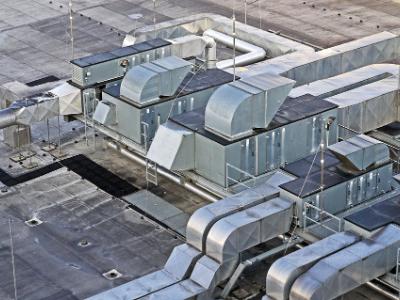
What is Air Balancing and why is it important?
What Is Air Balancing and Why Is It Important?
Have you ever wondered why some parts of your office, retail space, hotel room, manufacturing or commercial building may feel warm while another room is freezing? Maybe you've complained to coworkers or managers about the thermostat being too high or too low. An air balance test measures the performance of HVAC equipment and hiring a certified HVAC balancer is essential.
What Is Air Balancing and Testing?
Air balancing tests a building or home's heating and cooling system. When operating optimally, warm or cool air will be evenly distributed without any hot or cold spots, running at maximum energy efficiency. Modern central air conditioning system units can be extremely complex, which makes hiring certified air balance technicians absolutely essential.
In new buildings, certified professionals use the specifications created by a mechanical engineer to optimize airflow until the requirements for the HVAC system in the plans are met. When the building's airflow pattern is in tune, the technician locks the dampers and devices so the settings don't change.
Over time, dirty air filters, renovations, and remodeling can alter these locked-in settings. Air balancing services are required throughout the building's lifespan to make adjustments to maintain an ideal temperature throughout and optimal HVAC system function.
Why Does Air Balancing Matter?
No matter how efficient or well-maintained a heating system or air conditioner might be, there's still a possibility that it isn't providing even airflow throughout the building. This happens because all air conditioning systems use a duct system to distribute air through the building.
Advantages of Regular Air Balance Testing
When temperatures in one area never seem to be right, people often adjust the temperature to compensate. This wastes energy and money - and creates distracted, less productive people. When a new building is properly balanced by a certified professional, it will not only lower energy bills by performing more efficiently, but it also sets a path of preventative maintenance that improves the lifespan of the furnace and air conditioning system.
Regular balancing of an existing HVAC system also leads to better indoor air quality. Low airflow lets contaminants like pollen, mold spores, and airborne germs build up. With balanced airflow, air quality improves, smells fresher, and is healthier to breathe.
Methods of Air Balancing
Air balancing a distribution system is required to direct the airflow properly. During this process, flow rates are tested, adjusted, and balanced as either cubic feet per minute (CFM) or cubic meters per hour (m3/h).
In the two traditional methods of balancing airflow, an HVAC professional uses equipment to conduct diagnostic tests on various aspects of your system's performance. Sequential balancing involves setting the zone and branch dampers in sequence.
Proportional Balancing
Proportional balancing is the most common method of air balancing. With this method, air balancing hoods, also known as capture hoods, are placed over the air supply registers to measure the amount of air coming through.
Manometers are used to measure air pressure inside the system to locate blockages inside the ductwork. To test humidity levels, HVAC technicians use hygrometers. The combination of data from these tests determines how well the system is performing.
At this point, any issues that have been uncovered can be corrected. Often, damaged ductwork is causing uneven airflow through air leakage. This can be remedied by fitting and sealing loose duct joints, patching small holes, and replacing collapsed flexible ducts or severely damaged fiberglass or metal ducts.
Blockages caused by old air filters or deteriorating insulation can be removed as well. In other cases, design flaws in the original system - like undersized ducts or sharp turns in the duct system - cause the airflow imbalance. This occurs most often in multi-story buildings. While a complete redesign isn't practical, it's possible to redesign the worst areas to improve system performance.
Why Choose a Certified HVAC Test and Balancing Company?
Project owners should be alert when a project doesn't specify a certifying agency - that's a big red flag. Certified air balancing is best performed by independent professionals who have completed the Testing, Adjusting and Balancing Certification Program from the National Environmental Balancing Bureau (NEBB) or similar accrediting body.
A certified HVAC balancer has also passed examinations issued by their accrediting institution and completed a number of working or supervising hours doing the work itself.
HVAC companies applying for certified status must have a senior technician on staff who checks, approves, and signs off on all air balancing jobs. This person must also pass a certified written exam as well as a report review exam. Certified testing engineers need to have at least 8 years of air balancing experience or an engineering degree with 4 years of on-the-job experience. They need to oversee instrument calibration, technician training, and safety as well as submit their company's standard operating procedures to NEBB to obtain company certification.
Certification Agencies
The AABC is one of the most important certifications for architects and engineers to add when writing specs. AABC companies must be independent of any mechanical install or design on a project. If a company designs, installs and balances their own work, they may be biased and not want to find issues with their own work - and if they do, they may be reluctant to report their findings to the project owner. Additionally, an AABC certified company goes through an extensive onboarding and testing process to become a certified company based on knowledge, integrity, and independence. Project owners can rest assured that AABC certification is backed by a national guarantee that ensures if the TAB process isn't completed properly, they'll send someone to fix the issues. No other certification agency does this.
NEBB is the largest certifying organization for HVAC balancers. It provides training opportunities for both owners and their staff. Many members are independent. Both NEBB and TABB allow mechanical contractors to design, install, and assess their own work.
TABB, the Test and Balance Bureau is the only organization that certifies union entities. They pride themselves on being union trained through their partnership with the International Training Institute (ITI). TABB certified technicians go through extensive apprenticeships to learn all aspects of mechanical and sheet metal work: welding, CAD, mechanical install, fabrication, etc...
MTI is certified not only by NEBB but also by the Associated Air Balance Council (AABC) and the Test and Balance Bureau (TABB) as well. Being certified by all three organizations gives us full project awareness and better able to satisfy our customers' needs. In today's economy when business owners are trying to open their doors, getting a ventilation balance report showing optimum airflow rates gives both employees and patrons a sense of security that fresh air is entering the building, creating a safer, cleaner indoor environment.




